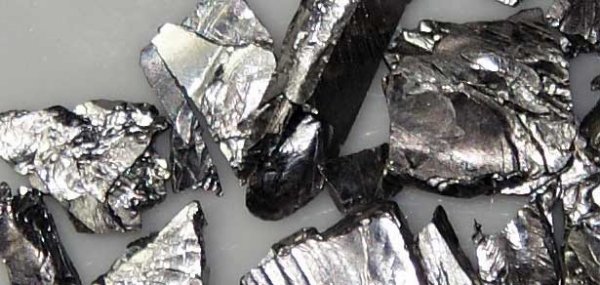Overview
From jewelry to automobiles, platinum, rhodium, palladium, and osmium play an essential role in the daily functions of developed nations. Although the world's supply of these so-called platinum group elements (PGEs) is not in danger of depletion in the foreseeable future, it is vital that we address environmental and humanitarian concerns in order to properly obtain and use these important elements.
Properties and Applications
PGEs are soft, ductile, silvery metals which are resistant to oxidation and corrosion, making them a good choice for multiple applications from catalytic converters to jewelry ("Platinum," 2011).
Catalytic converters are meta l or ceramic honeycomb structures coated with PGEs. These converters serve as extremely effective pollution controls for automobiles. 90% of all hydrocarbons, nitrogen oxides, and carbon monoxides (responsible for smog, acid rain, and ozone depletion), are converted into carbon dioxide. Catalytic converters also control about 30-40% of particulate emissions, which are known to have a high concentration of carcinogens ("Platinum today: Autocatalyst").
l or ceramic honeycomb structures coated with PGEs. These converters serve as extremely effective pollution controls for automobiles. 90% of all hydrocarbons, nitrogen oxides, and carbon monoxides (responsible for smog, acid rain, and ozone depletion), are converted into carbon dioxide. Catalytic converters also control about 30-40% of particulate emissions, which are known to have a high concentration of carcinogens ("Platinum today: Autocatalyst").
PGEs also serve as excellent catalysts for many manufacturing processes. For instance, in the commercial production of nitric acid for nitrogen fertilizers, ammonium gas is oxidized by high pressure air over a platinum-rhodium catalyst ("Platinum today: Nitric Acid"). Platinum also serves as a catalyst in the curing of silicones which are important in applications as diverse as baking, bandages, and airplane gasket seals ("Platinum today: silicones").
Hydrogen fuel cells are another potential application of PGEs. Due to their resistance to oxidation and corrosion, platinum electrodes are excellent for this purpose. These fuel cells have the potential to provide large amounts of energy in an environmentally friendly and cost effective way ("Technologies").
Geology and Mining
There are large deposits of platinum group elements in the Merensky and Upper Group 2 reefs in South Africa ("South Africa"). These deposits were formed from silicate magma intrusions. Immiscible sulfide liquid saturates the magma and attracts PGEs along with copper and nickel (Zientek, 2012). As a result, even though the concentration of PGEs is extremely small, these mines are fairly economical because in the process of extracting platinum, copper and nickel are also extracted.
Other, smaller deposits do exist, including the Sudbury Basin, an impact crater in Ontario, in the Urals in Russia, and the Great Dike in Zimbabwe. And although these regions have been successful, the vast majority of platinum group elements available in the global market are mined in the more established mines of South Africa ("Platinum today: Production"). See the locations of deposits page for more information.
Refining
The raw ore extracted from mines must be further processed before the PGEs can be used for industrial purposes. The refining process begins with smelting at temperatures exceeding 1200 °C. This heating process separates the metals from the nonmetals. Following this step, various chemical reactions separate out and purify the PGEs. Though expensive to extract PGEs alone, the process is more economical than may be expected. This is because PGEs are often contained in ores with nickel and copper, which can be refined simultaneously to increase the profitability of the refinement process ("The Process").
Supply and Demand
PGE supplies are expected to increase in strategic importance in industry, and this necessitates attention. A constant supply of these elements is vital for continued pollution control through catalytic converters. PGEs will also become increasingly important as fuel cell technology increases (Bleiwas, 2004). See the PGE supply and demand page for more information.
Conclusion
In summary, PGEs are forecasted to continue to rise in importance. They are crucial to the transportation and energy industries in establishing environmentally-friendly technology. The limited availability of mines, isolated mainly to South Africa, may cause concerns for future supply, and the usage of PGEs in diverse sets of processes means that their importance cannot be ignored.
Bleiwas, Donald, I., Wilburn, D. (2004). Platinum-group metals—world supply and demand.
Retrieved from http://pubs.usgs.gov/of/2004/1224/2004-1224.pdf
Platinum. (2011). Retrieved from
http://www.google.com/url?q=http://www.rsc.org/periodic-table/element/78/Platinum&sa=
D&sntz=1&usg=AFQjCNEIUgSpxtF7Nb_qEfhxoGkmvfGaWg
Platinum today: autocatalyst. (n.d.). Retrieved from
http://www.platinum.matthey.com/applications/autocatalyst/
Platinum today: Nitric acid. (n.d.). Retrieved from
http://www.platinum.matthey.com/applications/industrial-applications/nitric-acid/
Platinum today: production. Retrieved from http://www.platinum.matthey.com/production/
Platinum today: silicones. (n.d.). Retrieved from
http://www.platinum.matthey.com/applications/industrial-applications/silicones/
South Africa. (n.d.). Retrieved from http://www.platinum.matthey.com/production/south-africa/
Technologies. (n.d.). Retrieved from http://www.fuelcelltoday.com/about-fuel-cells/technologies
The Process. (n.d.). Retrieved from
http://www.jmrefining.com/page-view.php?pagename=The-Process
Zientek, M. (2012). Magmatic ore deposits in layered intrusions—descriptive model for reef-type
pge and contact-type cu-ni-pge deposits. Retrieved from
http://pubs.usgs.gov/of/2012/1010/contents/OF12-1010.pdf

